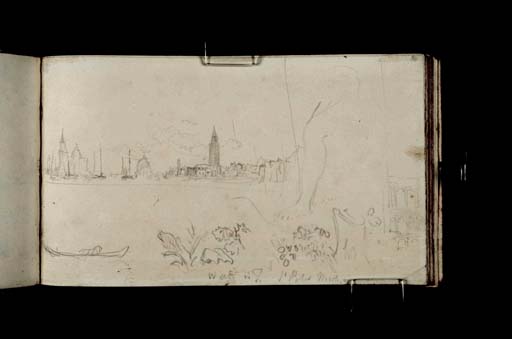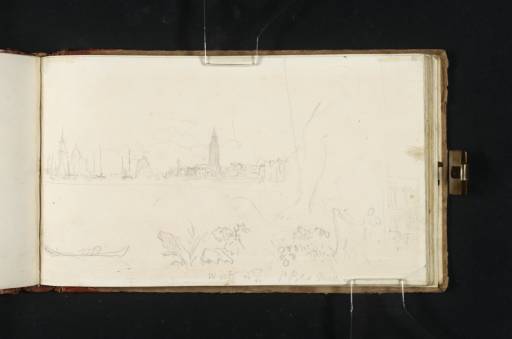Joseph Mallord William Turner Venice from the Bacino; Plants and a Leg from Titian's 'St Peter Martyr'; the Campanile and South Side of St Mark's Square 1819
Image 1 of 2
-
 Joseph Mallord William Turner, Venice from the Bacino; Plants and a Leg from Titian's 'St Peter Martyr'; the Campanile and South Side of St Mark's Square 1819
Joseph Mallord William Turner, Venice from the Bacino; Plants and a Leg from Titian's 'St Peter Martyr'; the Campanile and South Side of St Mark's Square 1819 -
 Joseph Mallord William Turner, Venice from the Bacino; Plants and a Leg from Titian's 'St Peter Martyr'; the Campanile and South Side of St Mark's Square 1819 (Enhanced image)Enhanced image
Joseph Mallord William Turner, Venice from the Bacino; Plants and a Leg from Titian's 'St Peter Martyr'; the Campanile and South Side of St Mark's Square 1819 (Enhanced image)Enhanced image
Joseph Mallord William Turner,
Venice from the Bacino; Plants and a Leg from Titian's 'St Peter Martyr'; the Campanile and South Side of St Mark's Square
1819
Joseph Mallord William Turner 1775–1851
Folio 40 Verso:
Venice from the Bacino; Plants and a Leg from Titian’s ‘St Peter Martyr’; the Campanile and South Side of St Mark’s Square 1819
D14390
Turner Bequest CLXXV 40a
Turner Bequest CLXXV 40a
Pencil on white wove paper, 112 x 185 mm
Partial watermark ‘Al | 18’
Inscribed by Turner in pencil ‘Weeds in T. St Peter Martyr’ towards bottom right
Partial watermark ‘Al | 18’
Inscribed by Turner in pencil ‘Weeds in T. St Peter Martyr’ towards bottom right
Accepted by the nation as part of the Turner Bequest 1856
References
1909
A.J. Finberg, A Complete Inventory of the Drawings of the Turner Bequest, London 1909, vol.I, p.513, CLXXV 40a, as ‘Distant view of Doge’s Palace; also part of leg of one of the figures, and weeds in foreground of Titian’s St. Peter Martyr – “Weeds in F. [sic] St. Peter Martyr.”’.
1930
A.J. Finberg, In Venice with Turner, London 1930, pp.54, 57–8, 163, as ‘“Weeds in T(itian’s) St. Peter Martyr”, with leg of one of the figures: also a distant view of S. Giorgio, the Salute, Ducal palace and Campanile’, pl.X, as ‘Weeds in Titian’s St. Peter Martyr’.
1974
John Gage in Martin Butlin, Andrew Wilton and Gage, Turner 1775–1851, exhibition catalogue, Royal Academy, London 1974, p.178 under no.B33, as ‘CLXXVI–40a’.
1983
Jerrold Ziff, ‘Turner et les grands maîtres’ in John Gage, Ziff, Nicholas Alfrey and others, J.M.W. Turner, à l’occasion du cinquantième anniversaire du British Council, exhibition catalogue, Galeries nationales du Grand Palais, Paris 1983, p.29 note 20.
1987
John Gage, J.M.W. Turner: ‘A Wonderful Range of Mind’, New Haven and London 1987, p.115.
2003
Ian Warrell in Warrell, David Laven, Jan Morris and others, Turner and Venice, exhibition catalogue, Tate Britain, London 2003, p.17.
2008
James Hamilton, ‘Turner e l’Italia’ in Hamilton, Nicola Moorby, Christopher Baker and others, Turner e l’Italia, exhibition catalogue, Palazzo dei Diamanti, Ferrara 2008, pp.43, 90 note 14.
2009
James Hamilton, ‘Turner’s Route to Rome’ in Hamilton, Nicola Moorby, Christopher Baker and others, Turner & Italy, exhibition catalogue, National Galleries of Scotland, Edinburgh 2009, pp.41, 150 note 14.
The miscellaneous drawings here are inverted relative to the sketchbook’s foliation. The Turner scholar C.F. Bell marked Finberg’s 1909 Inventory entry (‘Distant view of Doge’s Palace ...’): ‘Panorama from near San Biagio S. Giorgio to l. Salute in the middle’.1 Bell annotated Finberg’s similar entry in In Venice with Turner (1930): ‘from the Riva di San Biagio’.2 These notes apply to the view of Venice at the top left, seen to the west from a boat in the Bacino somewhere off the entrance to the Rio dell’Arsenale and the church of San Biagio, encompassing the churches of San Giorgio Maggiore on the left and Santa Maria della Salute at the centre, with the campanile of St Mark’s towards the right. The shading of the latter suggests a contre-jour afternoon effect. Compare the more detailed view on folios 61 verso–62 recto (D14432–D14433).
A strip of approximately 20 mm at the right-hand, outer edge is taken up with a continuation of the full-page view south across the Piazzetta on folio 41 verso (D14392), which Turner would have temporarily slid to the left in order to continue here.
The third element on the present page, which Finberg thought had been drawn first,3 indeed as ‘one of the first things that Turner went to see when he got to Venice’4 is the most idiosyncratic: a study of the foreground plants and tree stump and a single adjacent leg of one of the earthly protagonists in the 1528 St Peter Martyr altarpiece by the major Venetian painter Titian (c.1490–1576). The painting was then housed in the large Basilica of Santi Giovanni e Paolo (see folio 72 recto; D14453), but was destroyed by fire in 1867. Turner had first examined it directly when it was displayed at the Louvre in Paris in 1802, and wrote an extended commentary on it in his Studies in the Louvre sketchbook (Tate D04306–D04308; Turner Bequest LXXII 27a, 28, 28a); see David Blayney Brown’s transcription and notes under D04308.
Finberg suggested that Turner focused on this detail aspect as it had been mentioned particularly by the first President of the Royal Academy, Sir Joshua Reynolds (1723–1792), in his eleventh Discourse (1782),5 when he had declared that ‘the weeds in the fore-ground are varied ... just as much as variety requires, and no more’, rather than featuring the ‘minute discriminations of the leaves and plants’ described by an earlier writer,6 thus embodying Reynolds’s characteristic recommendation of ‘shewing the general effect’, since when the artist ‘knows his subject, he will know not only what to describe, but also what to omit’.7 Turner sketched the painting again, within the church’s interior, in his 1833 Venice sketchbook (Tate D31992–D31993; Turner Bequest CCCXIV 34a–35).8
Another sketchbook Turner carried with him on this tour includes travel and art notes by James Hakewill (1778–1843), with whom he had been collaborating on the Picturesque Tour of Italy (published in 1820); see Nicola Moorby’s Introduction to the Route to Rome book (Tate; Turner Bequest CLXXI). Numerous written notes by Turner and Hakewill are interspersed with drawn studies of sixteenth-century Venetian paintings including others by Titian and by Tintoretto (1518–1594); see Tate D13902–D13910, D13913–D13917 (Turner Bequest CLXXI 23a–27a, 29–31).
Towards the end of the present book are slight drawings of what may be a sculptural or armorial group, a painting of a townscape with figures, and another of a figure among trees, respectively on folios 83 recto, 87 verso and 90 recto (D14474, D14480, D14485; Turner Bequest CLXXV 83, 86a, 89). There is also what appears to be a record of a religious artwork in Milan on folio 91 recto (D14487; CLXXV 90), so it is possible that the other unidentified studies may not be from Venetian sources.
Undated MS note by C.F. Bell (died 1966) in copy of Finberg 1909, Tate Britain Prints and Drawings Room, I, p.513.
Undated MS note by Bell (before 1936) in copy of Finberg 1930, Prints and Drawings Study Room, British Museum, London, p.163, as transcribed by Ian Warrell (undated notes, Tate catalogue files).
How to cite
Matthew Imms, ‘Venice from the Bacino; Plants and a Leg from Titian’s ‘St Peter Martyr’; the Campanile and South Side of St Mark’s Square 1819 by Joseph Mallord William Turner’, catalogue entry, March 2017, in David Blayney Brown (ed.), J.M.W. Turner: Sketchbooks, Drawings and Watercolours, Tate Research Publication, July 2017, https://www

